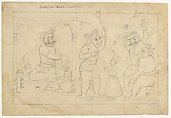Hiranyakashipu commands his demon warriors to threaten and injure Prahlada. Preparatory drawing from the ‘Small Bhagavata Purana’ Series
Attributed to Manaku Indian
Not on view
The famed Indian painter Manaku was active in the small court of Guler, Himachal Pradesh, in the hills of north-western India, from ca. 1725 to ca. 1760. Manaku is renowned for having illustrated two great corpuses of Indian religious literature, the epic Ramayana and the Bhagavata Purana, the latter a monumental work celebrating devotion to Vishnu in his various guises. Book 7 of the Bhagavata Purana is in large part devoted to recounting the legend of the avatar Narasimha’s vanquishing of the demon (asura) king Hiranyakashipu. This drawing is a preparatory study for a Narasimha-legend sequence of folios for one such edition of the Bhagavata Purana. The scene of the demons tormenting the devotee (bhakti) Prahlada evocatively captures the mood of the text, the diminutive figure of the youthful prince standing, his hands raised together reverently in anjali to plead for Vishnu’s protection. Around him are the looming figures of three grotesque demons, two of whom wield spear-tipped tridents, carrying out the instructions of the demon-king, seated enthroned in his palace.
Due to rights restrictions, this image cannot be enlarged, viewed at full screen, or downloaded.

